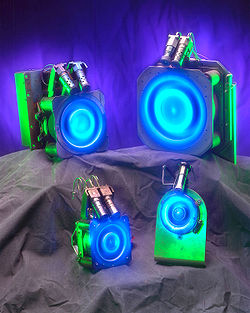
SPT-100 is a Hall-effect ion thruster, part of the SPT-family of thrusters. SPT stands for Stationary Plasma Thruster. It creates a stream of electrically charged xenon ions accelerated by an electric field and confined by a magnetic field. [1]
Contents
The thruster is manufactured by Russian OKB Fakel, and was first launched onboard the Gals-1 satellite in 1994. [2] In 2003, Fakel debuted a second generation of the thruster, called SPT-100B, and in 2011, it presented further upgrades in SPT-100M prototypes. [3] As of 2011, SPT-100 thrusters were used in 18 Russian and 14 foreign spacecraft, including IPSTAR-II, Telstar-8, and Ekspress A and AM constellations. [3]